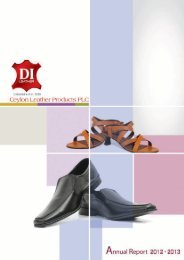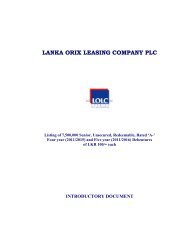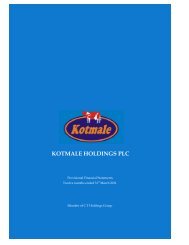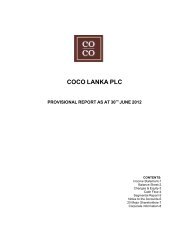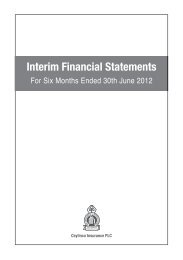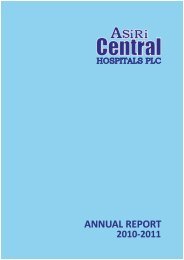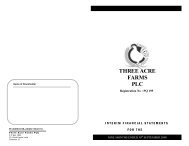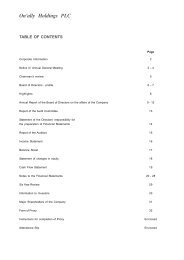Annual Report 2011/2012 - Colombo Stock Exchange
Annual Report 2011/2012 - Colombo Stock Exchange
Annual Report 2011/2012 - Colombo Stock Exchange
Create successful ePaper yourself
Turn your PDF publications into a flip-book with our unique Google optimized e-Paper software.
ACCOUNTING POLICIES<br />
ACCOUNTING POLICIES<br />
preparation of an opening Balance Sheet in accordance<br />
interest over the period, unless such interest is capitalized<br />
Financial liabilities will be either classified as fair value<br />
equity transactions and cannot be recognized as profit/<br />
with the new SLASs as at 01 April <strong>2011</strong>. This will form<br />
in accordance with LKAS 23 Borrowing Costs.<br />
through profit or loss or at amortized cost. At present, the<br />
loss on disposal of investments in the statement of<br />
the basis of accounting for the new SLASs in the future,<br />
Group does not identify, categorise and measure financial<br />
financial performance.<br />
and is required when the Group prepares its first new<br />
All site restoration costs including other environmental<br />
assets and liabilities as per the requirements of the<br />
SLAS compliant Financial Statements for the year ending<br />
restoration and similar costs must be estimated and<br />
standard and also does not recognise certain derivative<br />
(e)<br />
LKAS 12 – Income Tax requires deferred tax to be provided<br />
31 March 2013. Set out below are the key areas where<br />
capitalised at initial recognition, in order that such costs<br />
instruments on the balance sheet.<br />
in respect of temporary differences which will arise as a<br />
accounting policies will change and may have an impact<br />
can be depreciated over the useful life of the asset. This<br />
result of adjustments made to comply with the new SLAS.<br />
on the Financial Statements of the Group. The Group is<br />
standard requires depreciation of assets over their useful<br />
(d)<br />
SLFRS 3 – Business combinations will require the<br />
in the process of quantifying the impact on the Financial<br />
lives, where the residual value of assets is deducted to<br />
company to apply this standard to transactions and other<br />
(f)<br />
LKAS 18 – Revenue requires the Group to measure revenue<br />
Statements arising from such changes in accounting<br />
arrive at the depreciable value. It also requires that<br />
events that meet the new definition of a business i.e. an<br />
at fair value of the consideration received or receivable.<br />
policies.<br />
significant components of an asset be evaluated separately<br />
integrated set of assets (inputs) and activities (processes)<br />
It also specifies recognition criteria for revenue, and the<br />
for depreciation.<br />
which are capable of being conducted and managed to<br />
Group needs to apply such recognition criteria to the<br />
(a)<br />
SLFRS 1 – First Time Adoption of Sri Lanka Accounting<br />
provide a return, as opposed to a mere asset acquisition.<br />
separately identifiable components of a single transaction<br />
Standards requires the Group to prepare and present<br />
(c) LKAS 32 – Financial Instruments: Presentation, LKAS 39<br />
Under the new acquisition method of accounting, in<br />
in order to reflect the substance of the transaction.<br />
opening new SLFRS Financial Statements at the date of<br />
– Financial Instruments: Recognition and Measurement<br />
addition to recognizing and measuring in its financial<br />
transition to new SLAS. The Group shall use the same<br />
and SLFRS 7 – Disclosures will result in changes to the<br />
statements the identifiable assets acquired and liabilities<br />
accounting policies in its opening new SLAS Financial<br />
current method of recognizing financial assets, financial<br />
assumed the standard also requires recognition and<br />
Statements and throughout all comparable periods<br />
liabilities and equity instruments. These standards will<br />
measurement of any non-controlling interest in the<br />
presented in its first new SLAS Financial Statements.<br />
require measurement of financial assets and financial<br />
acquiree and re-measuring to fair value any previously<br />
LKAS 1 – Presentation of Financial Statements requires<br />
liabilities at fair value at initial measurement. The<br />
held interests which could have an impact on the<br />
an entity to present, in a Statement of Changes in Equity,<br />
subsequent measurement of financial assets classified as<br />
recognition of goodwill. Subsequent to the acquisition of<br />
all owner changes in equity. All non owner changes in<br />
fair value through profit and loss and available for sale<br />
control any acquisitions or disposals of non-controlling<br />
equity are required to be presented in one statement of<br />
will be at fair value, with the gains and losses routed<br />
interest without loss of control will be accounted for as<br />
comprehensive income or in two statements (a separate<br />
through the statements of comprehensive income and<br />
income statement and a statement of comprehensive<br />
equity respectively.<br />
income). Components of comprehensive income are not<br />
permitted to be presented in the statement of changes in<br />
Financial assets classified as held to maturity and loans<br />
equity. This standard also requires the Group to disclose<br />
and receivables will be measured subsequently at<br />
information that enables users of its financial statements<br />
amortized cost. These assets will need to be assessed<br />
to evaluate the entity’s objectives, policies and processes<br />
for any objective evidence of impairment as a result<br />
for managing capital.<br />
of one or more events that occurred after the initial<br />
recognition of the asset (a ‘loss event’) coupled with a<br />
(b)<br />
LKAS 16 – Property, Plant and Equipment requires a<br />
reliable estimate of the loss event (or events) impact on<br />
company to initially measure an item of Property, Plant<br />
the estimated future cash flows of the financial asset or<br />
and Equipment at cost, using the cash price equivalent<br />
group of financial assets . As such the current method of<br />
at the recognition date. If payment is deferred beyond<br />
assessing for impairment will have to be changed to meet<br />
normal credit terms, the difference between the cash<br />
the requirements of these new standards.<br />
price equivalent and the total payment is recognized as<br />
AMAYA LEISURE PLC<br />
96<br />
<strong>2011</strong>/12 ANNUAL REPORT<br />
AMAYA LEISURE PLC<br />
97<br />
<strong>2011</strong>/12 ANNUAL REPORT





